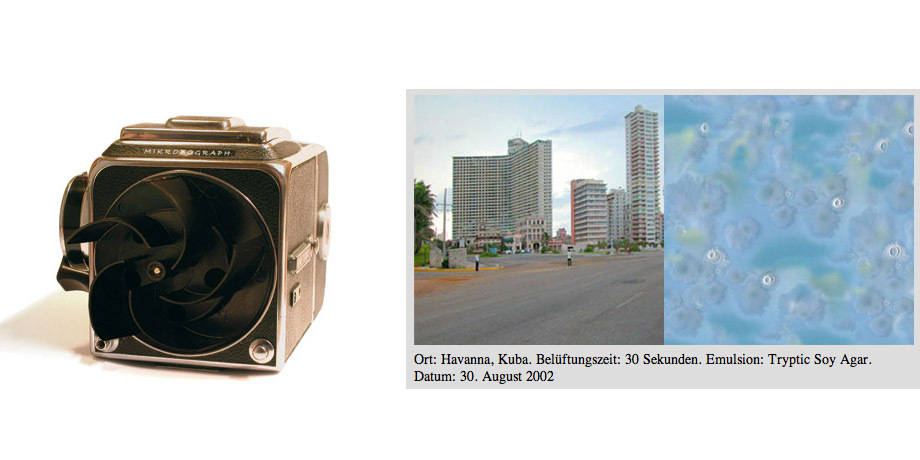
Mikrobograph, Apparat für bioindexikalische Aufnahmen, 2002
reconstructed Hasselblad 500C, 14 x 16 x 12 cm
In analogy to photography and Henry Fox Talbot's definition of the latter as "pencil of nature," microbography uses micro-organisms from the air around us to produce images. In contrast to photography, which is an opto-chemical technique, microbography relies on biological processes. Instead of a period of exposure, there is a period of aeration, during which microbes present in the breathing air are blown onto a film treated with a special emulsion. The latter consists of a nutrient agar which, comparable to a photographic film and its sensitivity to light, reacts to its surroundings. The film used is a broadband agar derived from soya, which is aerated for thirty seconds at a time. Before and after aearation, the film is stored in air-tight, sterilized containers. The development time, at room temperature, is between two and seven days, although the first microbial traces, visible to the naked eye, begin to grow within about 24 hours. Depending on the site of image-taking, the season, the time of day and the period of aeration, as well as the type of film emulsion used, microbographies thus emerge created by fungi and bacteria.
reconstructed Hasselblad 500C, 14 x 16 x 12 cm
In analogy to photography and Henry Fox Talbot's definition of the latter as "pencil of nature," microbography uses micro-organisms from the air around us to produce images. In contrast to photography, which is an opto-chemical technique, microbography relies on biological processes. Instead of a period of exposure, there is a period of aeration, during which microbes present in the breathing air are blown onto a film treated with a special emulsion. The latter consists of a nutrient agar which, comparable to a photographic film and its sensitivity to light, reacts to its surroundings. The film used is a broadband agar derived from soya, which is aerated for thirty seconds at a time. Before and after aearation, the film is stored in air-tight, sterilized containers. The development time, at room temperature, is between two and seven days, although the first microbial traces, visible to the naked eye, begin to grow within about 24 hours. Depending on the site of image-taking, the season, the time of day and the period of aeration, as well as the type of film emulsion used, microbographies thus emerge created by fungi and bacteria.